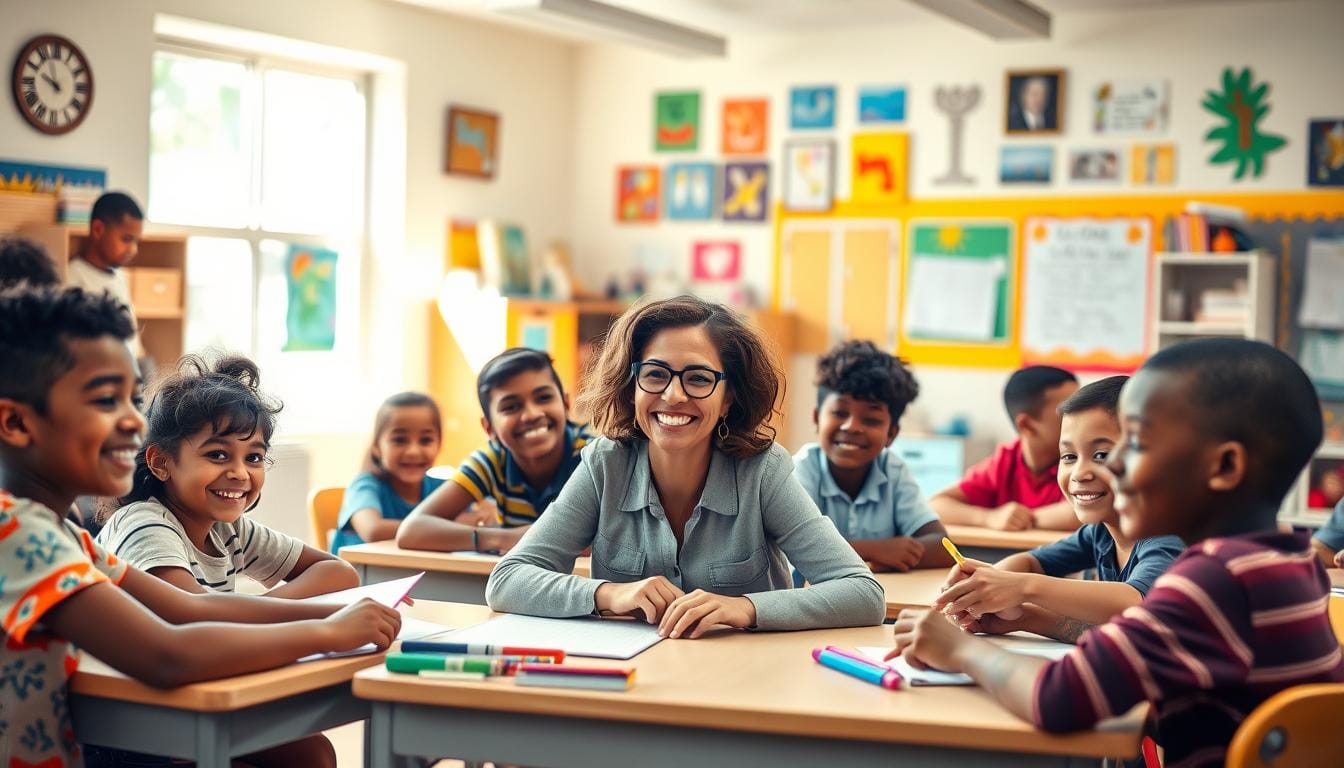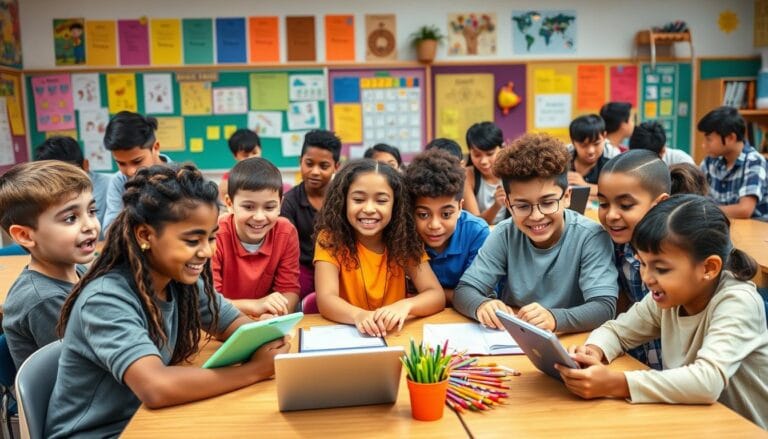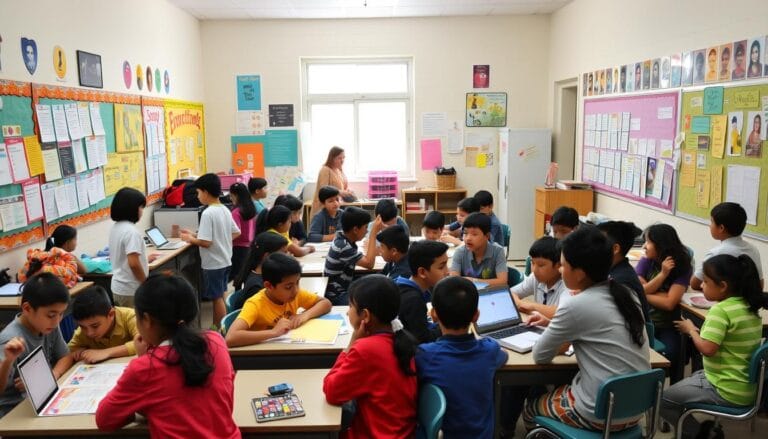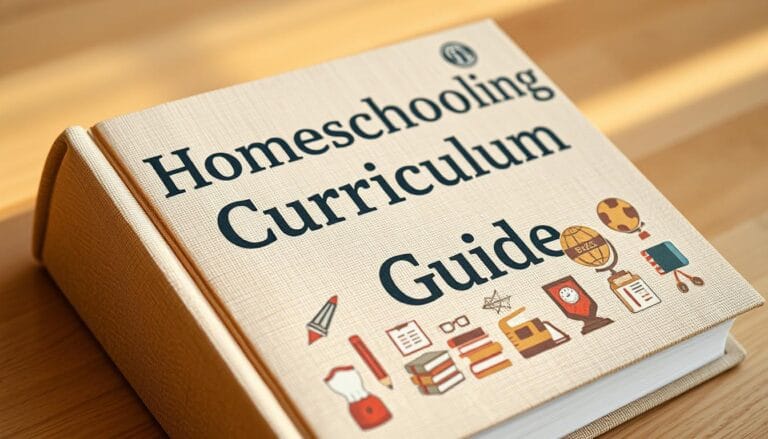Classroom Culture: 5 Tips for Teachers to Foster Inclusion
Every classroom has its own story. Teachers have the chance to write a tale of acceptance and growth. The culture we build can change lives, breaking down barriers for all students.
Education has changed a lot in the last 20 years. In 2019, over 65% of students with disabilities learned in inclusive classrooms. This shows our growing effort to celebrate diversity in schools.
Picture a classroom where every student is valued and heard. Where differences are seen as strengths. This is what an inclusive classroom is all about—a place where everyone’s potential is recognized and supported.
Table of Contents
In the next parts, you’ll learn five key ways to make your classroom a supportive place. These strategies will help you create a culture that empowers all students, no matter their background or abilities.
Understanding the Importance of Inclusive Education
Inclusive education makes classrooms better places for all students. Teachers use culturally responsive teaching to make learning fun for everyone. This way, students from all walks of life can succeed together.
Modern education shows us how important inclusive learning is. Studies show big benefits for students in many areas.
Current Educational Trends
- Students in inclusive settings show 40% higher academic progress in mathematics and reading
- Peer support significantly enhances classroom participation and assignment completion rates
- Inclusive classrooms develop critical life skills like empathy and teamwork
Impact on Student Performance
Students with different learning needs do better in inclusive classrooms. Research shows big gains in their skills and how they interact with others.
| Learning Dimension | Improvement Percentage |
|---|---|
| Academic Achievement | 35% |
| Social Skills Development | 45% |
| Emotional Well-being | 50% |
Key Benefits of Inclusive Learning
Inclusive education gets students ready for a world that’s diverse and connected. Schools that value respect and understanding help students:
- Think critically
- Accept others
- Communicate better
“Inclusive education is not about removing challenges, but about providing opportunities for every student to succeed.” – Educational Research Institute
Teachers who use culturally responsive teaching make learning special for each student. They see and celebrate each student’s unique background and talents.
Creating a Safe and Supportive Learning Space
Creating a safe classroom is more than just a physical space. It’s about making a place where everyone feels valued and emotional intelligence grows. Studies show that students who feel accepted are more likely to take risks and learn more.
To build a nurturing classroom, you need a plan. Positive reinforcement is key to boosting student confidence and getting them involved. With the right strategies, your classroom can become a place of growth and learning.
“When students feel respected, they become active participants in their own education.” – Educational Research Insights
- Establish clear, collaborative classroom agreements
- Practice consistent, supportive communication
- Create opportunities for student voice and choice
- Develop routines that reduce stress and facilitate learning
Good classrooms use social-emotional learning. Programs based on research show big improvements in learning spaces. Morning meetings, for example, help build community and emotional smarts.
What makes a classroom supportive includes:
- Regular circle discussions that allow students to share without interruption
- Collaborative norm-setting processes
- Consistent reinforcement of respectful interactions
Remember, your classroom is more than a physical space—it’s a community where every student can grow, learn, and feel truly supported.
Classroom Culture: Essential Elements for Success
Creating a great classroom environment is more than just teaching. It’s about managing the classroom well and building strong relationships with students. Studies show that positive classrooms lead to better student results.
To make a classroom successful, you need to engage students and make learning fun. Let’s look at the important parts that turn ordinary classrooms into exciting places to learn.
Building Trust and Rapport
Connecting with students is key to being a great teacher. How you create a supportive space affects how well students do in school. Here are some tips:
- Listen well when talking to students
- Show real interest in their lives
- Always treat them fairly
- Give feedback that’s personal and helpful
Establishing Clear Expectations
Being clear helps students feel secure and know what’s expected. Clear classroom rules make everyone feel safe and understood. Make sure students know what’s expected of them.
- Work together to set classroom rules
- Post expectations where everyone can see them
- Always stick to the rules you’ve set
- Explain why each rule is important
Fostering Open Communication
Good communication changes how a classroom works. Schools that focus on teamwork see more support and involvement. Make sure students feel free to share their thoughts and worries.
“The most important thing in communication is hearing what isn’t said.” – Peter Drucker
By focusing on classroom management and building strong relationships, you can make a place where students thrive. This supports their learning and personal growth.
Implementing Differentiated Instruction Strategies
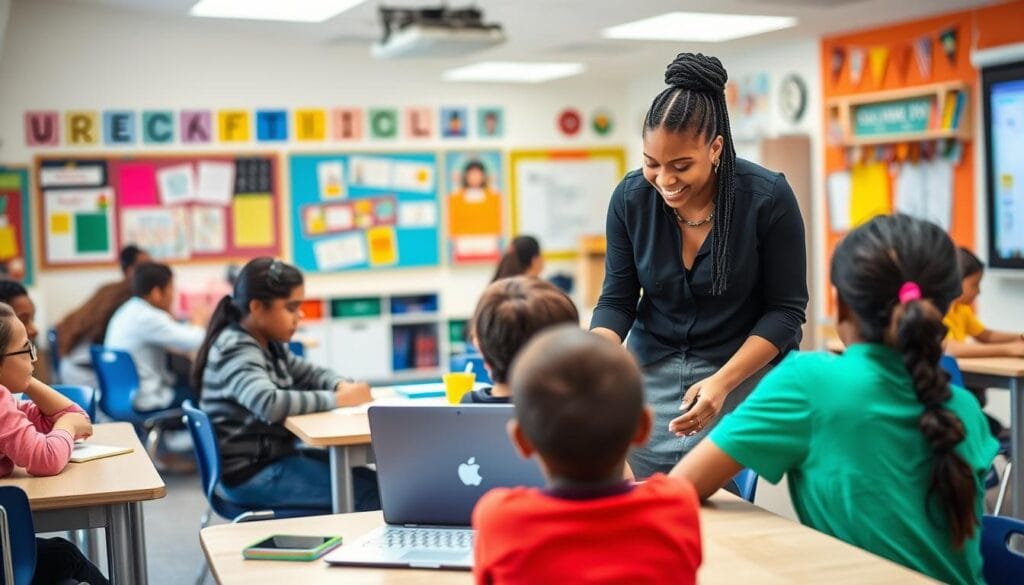
Differentiated instruction changes how we teach by seeing that each student learns in their own way. Your classroom can become a place where everyone learns together and grows individually.
“Great teaching is about creating multiple pathways to knowledge, not a single route.” – Educational Innovation Expert
Today’s teachers know that one way of teaching doesn’t work for everyone. Studies show that 85% of teachers agree that different students need different teaching methods.
- Personalize learning experiences
- Adapt teaching methods
- Support individual student strengths
Using different teaching methods can make your classroom better. Research shows these methods can:
| Strategy | Impact |
|---|---|
| Flexible Grouping | 35% Enhanced Student Engagement |
| Technology Integration | 15% Performance Improvement |
| Collaborative Learning | 30% Academic Performance Boost |
Strategies like choice boards, tiered assignments, and learning contracts let students control their learning. This approach makes your classroom a place where everyone can succeed.
Getting better at teaching different ways is important. Training can make teachers 40% more effective and help manage classroom issues better.
Promoting Cultural Awareness and Sensitivity
Creating an inclusive environment is more than just good intentions. Culturally responsive teaching makes classrooms places where every student feels valued. It’s about building real connections and understanding.
Students do better when their cultural backgrounds are recognized and celebrated. Studies show classrooms that value diversity can increase student engagement by 30%. They also see better academic results.
Celebrating Diversity Through Curriculum
Creating an inclusive curriculum means adding perspectives from different cultures. Here are some ways to do it:
- Choose textbooks that tell stories from various cultures
- Include books written by authors from different ethnicities
- Make assignments that let students explore different cultures
- Use multimedia that shows global views
Incorporating Multicultural Resources
“Cultural diversity is wisdom materialized in practice.” – Unknown
Good multicultural resources make learning better. Here are some ways to use them:
- Use learning materials in many languages
- Start cultural exchange programs
- Invite speakers from different backgrounds
- Do projects that bring together different cultures
Addressing Cultural Biases
It’s important to recognize and tackle cultural biases. Teachers need to keep checking themselves and fight hidden prejudices.
| Bias Type | Impact | Mitigation Strategy |
|---|---|---|
| Unconscious Stereotyping | Limits student potential | Regular bias training |
| Language Preference | Marginalizes non-native speakers | Inclusive communication techniques |
| Cultural Misunderstandings | Reduces classroom harmony | Promote cultural dialogue |
By using culturally responsive teaching, you make a place where every student can thrive. They can learn, succeed, and feel truly seen.
Developing Effective Communication Methods
Communication is key to student engagement and emotional intelligence in today’s classrooms. It’s not just about giving instructions. It’s about creating a supportive space where students feel heard and valued.
“Communication works for those who work at it.” – John Powell
Teachers can improve their communication skills in many ways. They can use strategies that help students understand and connect better. About 75% of what we communicate is nonverbal, like body language and tone.
- Practice active listening techniques
- Use clear and inclusive language
- Recognize non-verbal communication cues
- Encourage open dialogue
Different communication strategies can really help students. Studies show that listening well can make students trust teachers more, up to 30%. This makes learning together better.
| Communication Strategy | Potential Impact |
|---|---|
| Clear Instructions | Reduces task misunderstanding by 40% |
| Consistent Feedback | Enhances learning outcomes by 30% |
| Inclusive Language | Promotes student emotional intelligence |
By focusing on communication, teachers can make their classrooms more engaging. They can meet each student’s needs and help them feel part of the group.
Building Strong Teacher-Student Relationships
Creating meaningful connections in the classroom is more than just teaching. A strong bond between teachers and students is key to a supportive learning space. Studies show that positive relationships boost student motivation and grades.
Active Listening Techniques
Good communication starts with listening well. Teachers can improve their listening by:
- Maintaining eye contact
- Asking open-ended questions
- Showing empathy and understanding
- Providing verbal and non-verbal acknowledgment
“Listening is a form of acceptance.” – Mihaly Csikszentmihalyi
Creating Meaningful Connections
Building trust is vital. The 2×10 approach is a great way to do this. Spend two minutes each day for ten days with each student. This creates personal connections that boost engagement.
Supporting Individual Growth
Supporting each student’s growth changes the classroom. Teachers can:
- Use learning strategies that fit each student
- Offer emotional support tailored to each student
- Celebrate each student’s achievements
- Make a safe space for students to be open
The American Psychological Association says students feel better and do better in school when they feel supported by their teachers.
Utilizing Universal Design for Learning Principles
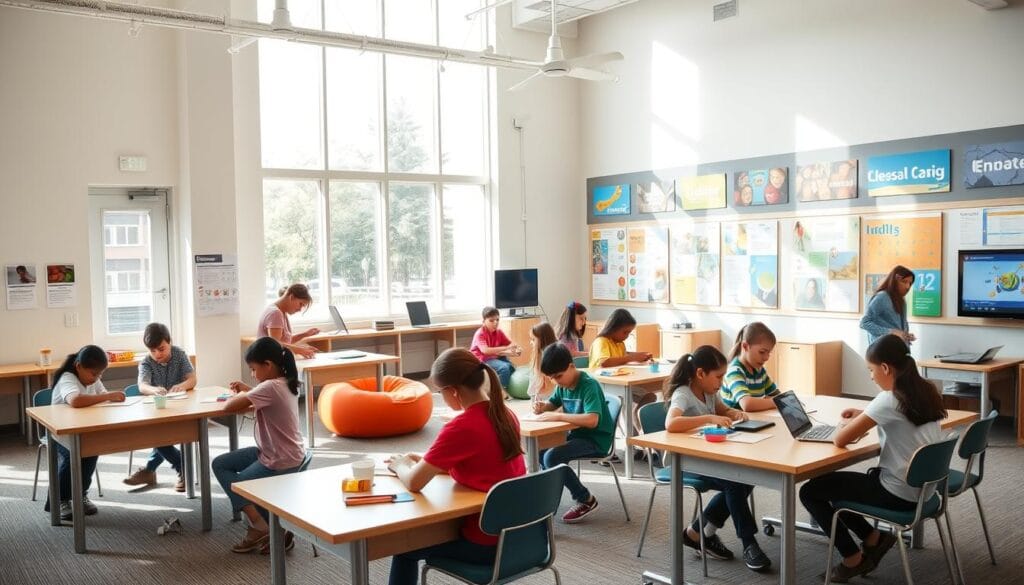
Universal Design for Learning (UDL) is a powerful way to change how we manage classrooms and encourage teamwork. It sees each student’s brain as unique, like a fingerprint. It believes in using flexible learning methods to help students reach their full potential.
“UDL aims to support learners to become expert learners who are purposeful, resourceful, and strategic.” – CAST Research Team
The UDL framework has three key principles that change how we teach:
- Engagement: Motivating students and answering the “why” of learning
- Representation: Showing information in different ways to cover the “what” of learning
- Action & Expression: Giving students many ways to show they understand
By using UDL, you can make your classroom more welcoming. This approach helps remove barriers to learning and supports students’ success. Studies show UDL can boost student involvement by more than 75% in many educational settings.
| UDL Principle | Key Focus | Classroom Impact |
|---|---|---|
| Engagement | Motivation and Purpose | Increased Student Participation |
| Representation | Information Diversity | Enhanced Learning Accessibility |
| Action & Expression | Multiple Demonstration Methods | Improved Student Agency |
By adopting UDL, your classroom management can improve. This approach doesn’t replace different teaching methods but makes learning more inclusive. It helps create environments where everyone can thrive.
Establishing Collaborative Learning Environments
Creating dynamic classrooms needs a smart plan for teamwork. Students do best in places that support working together and sharing discoveries.
Collaborative learning changes how we learn by letting students teach each other. Studies show groups of four to five students work best. This size helps everyone learn more and share ideas better.
Group Work Strategies
Good group work needs a few key steps:
- Assign clear roles within each group
- Set specific goals and expectations
- Use real-world tasks that connect to students’ lives
- Make sure everyone in the team is involved
Peer Support Systems
Strong peer support systems boost learning a lot. When students see teamwork as a way to grow, they develop a growth mindset.
“Learning is not a spectator sport. Students must talk about what they are learning, write about it, relate it to past experiences, and apply it to their daily lives.” – Education Researcher
Team Building Activities
Team building activities are key to breaking down barriers. Games are great for warming up and building teamwork skills while keeping learning fun.
- Rotate group memberships regularly
- Design interactive problem-solving challenges
- Give chances for reflection
- Evaluate groups based on individual merits
By focusing on teamwork, teachers can get students ready for today’s team-based world.
Conclusion
Creating an inclusive environment is more than a goal—it’s a way to change education. Teachers who use classroom culture strategies can really boost student engagement. Studies show up to 40% more students participate in well-run classrooms.
Your work to make classrooms inclusive is key. By using diverse materials, team work, and clear talk, you can cut down on bad behavior by 30%. This creates a place where everyone feels supported and valued.
An inclusive classroom does more than help students learn. When students feel respected, they’re 50% more likely to join in discussions. Your efforts can make students feel better about themselves, more motivated, and improve their learning.
Keep thinking about and changing your teaching methods. An inclusive classroom is always growing and changing. It helps every student learn and grow in your care.


